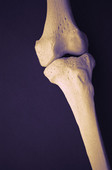
TUESDAY, Nov. 30 (HealthDay News) — Despite calls by some experts that Americans take in much more vitamin D, a new report from the Institute of Medicine finds that most people are getting enough of the nutrient each day.
The IOM did bump up the recommended dietary allowance of vitamin D from the amount cited in their last report, released 13 years ago.
For many people, 600 international units (IUs) of vitamin D or more each day will maintain bone health, but those aged 71 and older may need as much as 800 IUs daily, the IOM experts say. That’s up from 1997 recommendations, which advised 400 IUs per day for people aged 51 to 70 and 600 IUs per day for those over 70.
“The majority of Americans and Canadians do achieve these levels,” said report co-author Dr. Steven K. Clinton, a professor in the division of medical oncology at Ohio State University. “We don’t feel there is a widespread problem of inadequacy,” he said.
“Most people will eat enough diverse range of foods to achieve the recommended allowance,” Clinton added.
The IOM experts also say that most Americans are getting enough bone-strengthening calcium in their daily diet, sticking with generally accepted recommended dietary allowances of between 700 milligrams to 1,300 milligrams per day, based on a person’s age.
These updated recommendations are based on a review of almost 1,000 studies and testimony from scientists and others. Much of the evidence confirmed the importance of calcium and vitamin D in promoting bone health.
The new vitamin D recommendation, in particular, may come as a disappointment to some experts who believe that vitamin D can fight a range of diseases and have called for daily levels of vitamin D of up to 2,000 IU per day.
Many health claims beyond bone health have been made for vitamin D, which is found in certain foods but is primarily synthesized by the body through the activity of UV sunlight on the skin. The report committee reviewed hundreds of studies and reports on potential benefits other than bone health, such as protection against cancer, heart disease, autoimmune diseases and diabetes.
However, Clinton said the studies provided conflicting results and do not offer the evidence that confirms these additional benefits of vitamin D.
“What we have are intriguing other areas that warrant research,” he said. “Yet the data at the moment is insufficient with regards to defining an appropriate intake. Bone health is the primary outcome.”
As for calcium, the committee found that 700 milligrams per day of the nutrient is enough for almost all children aged 1 through 3, and 1,000 milligrams is right for almost all children aged 4 through 8. In addition, children and adolescents 9 through 18 need no more than 1,300 milligrams per day, Clinton noted.
For most adults aged 19 through 50 and for men up to 71 years, 1,000 milligrams daily is sufficient. For women aged 51 and older, and for both men and women aged 71 and older, 1,200 milligrams a day is enough, according to the report.
Clinton said that these levels are easily reached through a healthy diet and without the need for nutritional supplements.
The report also defined the upper safe levels of calcium and vitamin D, but stressed that people should not strive to reach these levels, since taking in too much of the nutrients brings its own hazards.
For vitamin D, the uppermost levels are 2,500 IUs per day for children aged 1 through 3; 3,000 IUs daily for children aged 4 through 8; and 4,000 IUs daily for everyone else.
For calcium, these outer ranges are 2,500 milligrams per day from age 1 through 8; 3,000 milligrams daily from age 9 through 18; 2,500 milligrams daily from age 19 through 50; and 2,000 milligrams per day for all others.
Taking in too much calcium from supplements has been linked with kidney stones, while excessive vitamin D consumption can damage the kidneys and heart, the report stated.
Evidence of other risks associated with vitamin D supplements is still unclear. However, there are suggestions of greater risks of death and chronic disease with long-term high intake of vitamin D, the committee noted.
The report’s recommendations for vitamin D do not include increasing sun exposure, which can boost the risk for skin cancer.
Dr. Sundeep Khosla, president of the American Society for Bone and Mineral Research, said that “the recommendations overall are very sound.”
Khosla also agreed that most people get enough calcium in their diet, particularly if they eat dairy foods. “One of the misconceptions people might have is they need to take what they get in their diet plus 1,200 milligrams of supplements,” he said.
For vitamin D, taking a multivitamin plus diet will get people to the amount they need, he said.
However, Dr. Michael Holick, director of the General Clinical Research Center at Boston University Medical Center, expressed disappointment in the recommendations for vitamin D.
Holick believes that most people should be taking vitamin D supplements.
“I think there is no downside to people increasing their vitamin D intake,” he said. “I personally get 3,000 IU of vitamin D a day. I have most of my patients on 3,000 IU a day and they are all in good shape.”
This level of vitamin D will maximize bone health and not be toxic in any way and “may have some additional benefits,” Holick said.
A group representing the nutritional supplements industry agreed that the IOM report fell short when it came to vitamin D.
“While an increase in the recommendations for vitamin D will benefit the public overall, such a conservative increase for the nutrient lags behind the mountain of research demonstrating a need for vitamin D intake at levels possibly as high as 2,000 IU/day for adults,” Andrew Shao, senior vice president of scientific and regulatory affairs at the Washington, D.C.-based Council for Responsible Nutrition, said in a news release.
As for calcium, Holick thinks the recommendations are correct and those levels can be easily achieved from diet. Only if you are not getting sufficient calcium through your diet should you be taking a supplement, he said.
More information
For more information on vitamin D, visit the U.S. National Institutes of Health.

